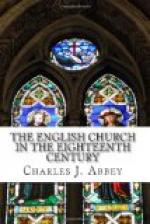[Footnote 834: One of Newton’s bon-mots was, ’The place of honour in an army is not with the baggage or among the women.’]
[Footnote 835: See one of Newton’s characteristically tender and sympathetic letters in answer to Hannah More’s description of her spiritual state: ’What you are pleased to say, my dear madam, of the state of your mind, I understand perfectly well; I praise God on your behalf, and I hope I shall earnestly pray for you. I have stood upon that ground myself. I see what you want, to set you quite at ease; and though I cannot give it you, I trust that He who has already taught you what to desire will in His own best time do everything for you and in you which is necessary to make you as happy as is compatible with our present state of infirmity and warfare; but He must be waited on and waited for, to do this.’ Hannah More had before this expressed her liking for Newton’s ’Cardiphonia, though not for every sentiment or expression which it contains.’ See Roberts’ Life, i. 236.]
[Footnote 836: Roberts, ii. 260.]
[Footnote 837: See Life of H. More, by H. Thompson, p. 81.]
* * * * *
CHAPTER X.
CHURCH FABRICS AND SERVICES.
Thirty years or more of the present century had passed before the Church awoke to put its material house in order, to improve and beautify its churches, and to improve the character of its services. Church buildings and Church services, as they are remembered by men yet of middle age, were very much the same at the close of the Georgian period as they were at its beginning. Much, therefore, of the present chapter will exhibit a state of things in many respects perfectly familiar to men who are still in the prime of life. Our great-great-grandfathers would have felt quite at home in many of the churches which we remember in our childhood. They would find now a great deal that was strange to them. Though Prayer-book and Rubrics remain the same, Church spirit in our day does not own very much in common with that which most generally prevailed during the reigns of the four Georges.
In a Church like this of England, where so much liberty of thought and diversity of opinion has ever been freely conceded to bishops and clergy as well as to its lay members, there has never failed to be, to some extent at least, a corresponding variety in the outward surroundings of public worship. From the beginning of the Reformation to the present day, the three principal varieties of Church opinion known in modern phraseology as ‘High,’ ‘Low,’ and ‘Broad’ Church have never ceased to co-exist within its borders. One or other of the three parties has at times been very depressed, while another has been popular and predominant. But there has never been any external cause to prevent the revival of the one, or to make it impossible that the other should not, with changing




